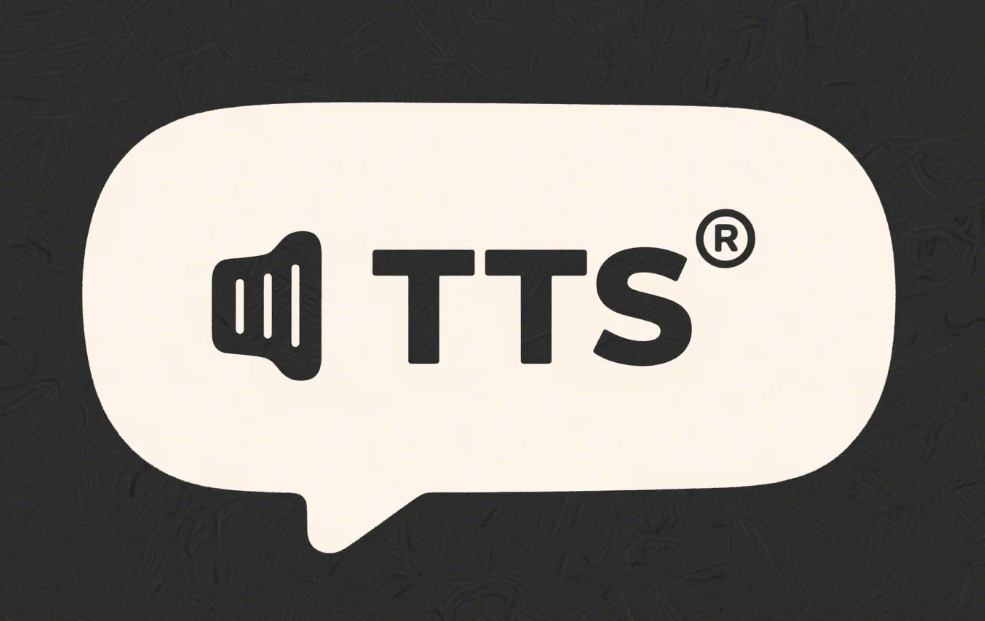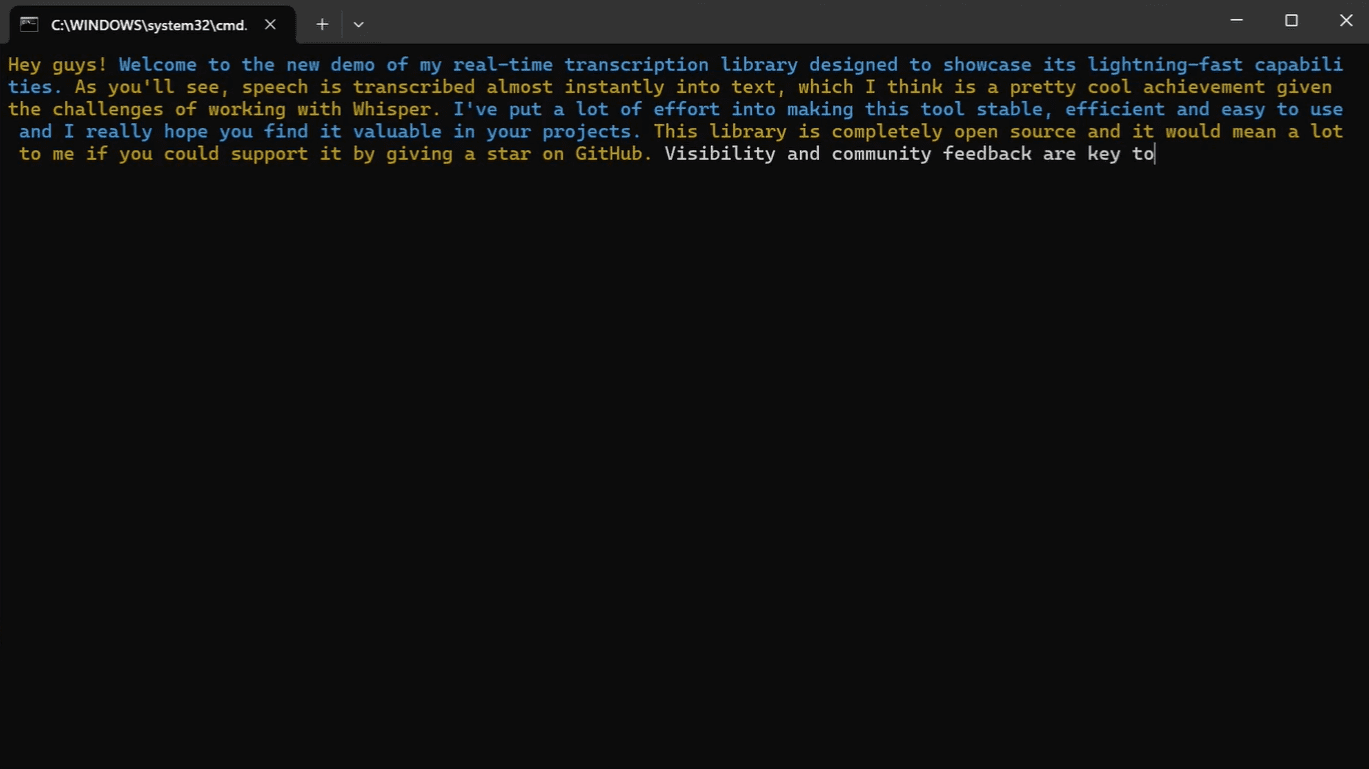Dify Workflows and AI Intelligent Assistants Reinvent the Enterprise Data Adoption Model
With the wave of digitization sweeping the world today, data has become the core asset of enterprises. How to quickly extract valuable information from massive business data and present it in an intuitive and easy-to-understand way is the key for enterprises to stand out in the fierce market competition. At the same time, an efficient information transfer mechanism is like the nerve veins of an enterprise, ensuring that instructions and data can reach every "cell" in a timely and accurate manner.
In the past, traditional ways of acquiring and presenting data were inconvenient, inefficient and costly. Now, with the rapid development of technology, Dify workflow and intelligent assistants and other innovative solutions that integrate AI technology have emerged. These transformative solutions have revolutionized the traditional model, allowing users to quickly access the data they need by simply describing their needs to an intelligent assistant. Data developers no longer need to go through the complex development process of data reports, but simply utilize the Dify Dify workflow is like installing a powerful digital engine for the enterprise, which greatly improves operational efficiency and injects a strong impetus for the digital transformation of the enterprise. In this article, we will take the project management system as an example to show the application of this new method in data acquisition and presentation.
1. Challenges facing enterprise data applications
Business teams and data teams often face their own pain points during data operations in an organization, and there are pressing issues at the system level that need to be addressed.
Pain points for business teams: When it comes to data insights, business teams need to go through a series of links and layers of requirements before they can see the final data and conclusions, which results in long waiting times and greatly affects decision-making efficiency. Many business people are unfamiliar with data processing tools such as Excel, or need to export data from the system in order to analyze it, and have to leave the data organization and development work to professional IT teams. However, the IT team's responsiveness often struggles to meet the rapidly changing needs of the business sector. Tasks that can be completed in minutes using Excel can take days for the IT team to deliver, severely limiting business flexibility and responsiveness.
Pain points for data teams: Data teams often need to invest a lot of time and effort in developing a large number of reports to respond to various data needs from business units and leaders. In order to satisfy just a few minutes of data query from the business and leadership, the data team may need to spend a week or even longer to complete a series of work such as data cleansing, report development and deployment. This inefficient work pattern not only consumes a lot of energy of the data team, but also makes it difficult to realize the value of the data.
System integration pain points: When business people need to obtain data from multiple data sources for analysis, they often need to log in to multiple different business systems, which is cumbersome and inefficient. What's more, some systems don't support mobile interface, which makes users unable to access data anytime and anywhere, further limiting the application scenarios and convenience of data.
In the face of all these pain points, enterprises are in dire need of a smarter and more efficient data analysis method to enhance data application and empower business development. Intelligent analytics has emerged to address these drawbacks of the traditional data application model.
2. Comparison of multiple technology routes: NLP2SQL vs. NLP2API vs. NLP2Python
Intelligent analytics can be realized in a variety of ways, each with its own advantages and disadvantages. Currently, the mainstream technology routes in the industry mainly include NLP2SQL, NLP2API and NLP2Python.
2.1. NLP2SQL
The core function of NLP2SQL is data extraction. This technical solution leverages a large-scale language model (LLM) by fine-tuning or using SQL training datasets to enable the model to understand natural language and generate corresponding SQL query statements. In the SQL generation phase, NLP2SQL still faces accuracy challenges. Especially when dealing with complex queries, e.g., queries that require correlation of multiple tables, in order to improve the accuracy of SQL generation, developers have to provide the model with detailed information about the structure of the data tables and field descriptions. In addition, the stability of large-scale models in determining inter-table relationships is relatively insufficient, which makes it easy to misjudge or generate incorrect SQL statements in complex data environments.
2.2 NLP2API
The core idea of the NLP2API approach is to semantically encapsulate the data and provide an API interface to the outside world. This approach is essentially similar to filling in the blanks. The developer defines the API interface and parameters in advance (equivalent to the blanks of a fill-in-the-blank question), and when the user puts forward the data query requirements, the large-scale model is responsible for understanding the user's intent, extracting the key parameters, and populating them with the predefined API parameters.The API interface is responsible for processing complex business logic and data query operations, and returning the results to the user. The advantage of NLP2API over NLP2SQL is that it is more stable; the API interface encapsulates the underlying complex logic, and the large-scale model only needs to focus on user intent understanding and parameter extraction, which reduces the possibility of errors.
2.3. NLP2Python
The NLP2Python solution leverages the flexibility and powerful ecosystem of the Python language. Developers can use Python code to flexibly handle a wide range of data analysis and processing tasks, breaking the limitations of SQL statements in certain scenarios. For example, Python code can be used to implement more sophisticated algorithmic predictive and attributional analysis models, and to combine these models with natural language interaction capabilities. However, NLP2Python solutions also face stability challenges, especially when errors in the model-generating Python code can cause the system to run abnormally. However, with the continuous improvement of large-scale model code generation capability and the advancement of code testing and verification techniques, the potential and application prospect of the NLP2Python scheme is also worth looking forward to.
2.4 Technological options
Taking into account the advantages and disadvantages of various technical routes, especially in the stability and accuracy of the trade-offs, the practice finally chose the NLP2API solution, which can better meet the needs of the enterprise in the query and analysis of data under the premise of ensuring the stability of the system.
3NLP2API Solution in Practice: Dify Workflow & Intelligent Assistant
3.1 Dify workflow concepts and roles
Dify Workflow is an innovative tool focused on low-code development. It adopts a simple and intuitive visual interface, allowing users to quickly build complex business processes through drag-and-drop and configuration, without writing a large amount of code to achieve efficient automation of the workflow.This feature of Dify workflow greatly reduces the technical threshold, so that business people and non-professional developers can easily participate in the design and construction of workflows, breaking down the communication barriers between developers and business people under the traditional development model, and achieving technical democratization. This feature of Dify workflow greatly reduces the technical barrier, so that business people and non-professional developers can also easily participate in the design and construction of workflow, breaking the traditional development model of the communication barriers between the developers and business people, and realize the technology democratization.
In the whole data processing process, Dify workflow plays a core orchestration role. When a user makes a data request, Dify workflow first conducts in-depth semantic analysis of the user's question, and accurately extracts key parameter information in the user's request through Natural Language Processing (NLP) technology and the built-in semantic understanding model. Based on this parameter information, Dify workflow can automatically obtain data from a variety of predefined data sources, including relational databases, file storage systems and third-party application program interfaces (APIs).
After acquiring the data, Dify workflow will process and transform the raw data flexibly according to the pre-set business rules and logic, such as data cleansing, data filtering, formatting, data aggregation and data computation, etc. After completing the data pre-processing, Dify workflow will seamlessly pass the processed data to the chart rendering session. After completing the data pre-processing, Dify workflow will seamlessly pass the processed data to the chart rendering process, which can intelligently select appropriate chart types (e.g., bar charts, line charts, pie charts, etc.) for visualization according to the characteristics of the data and the user's preference, making the data more intuitive and easy to understand.
Finally, in order to realize the rapid reach and efficient sharing of data, Dify workflow can also be deeply integrated with the commonly used instant messaging (IM) systems within the enterprise (e.g., enterprise WeChat), and Dify workflow can send the final chart results in the form of a message to the designated users, groups or departments, so as to realize the instant sharing and efficient delivery of data, thus bridging the "last kilometer" of data application. "The last kilometer".
3.2. AI-enabled parameter processing and result evaluation
Dify workflow makes full use of the powerful natural language processing capability of AI large-scale models to deeply analyze and understand the natural language questions posed by users, accurately identify users' real demands, and extract effective data query parameters from them. Then, Dify workflow can utilize these extracted parameters to automate the corresponding data extraction operations to obtain the target data from predefined data sources (e.g., databases, file systems, or other applications).
For example, when a user asks an intelligent assistant in Enterprise WeChat, "What is the total amount of tickets issued this week?" When such a question is asked, the Dify workflow can analyze the user query through an AI large-scale model to identify the user's concerns about theType of indicatoris the "total amount of notes issued".time dimensionis "this week", which in turn transforms natural language query into structured metadata information:
{
"type":"票据签发总额",
"time":"本周",
"start_date":"2024-12-16",
"end_date":"2024-12-22"
}
Another example is if a user asks "I want to know the overall total cell phone sales this year." Such a question, the Dify workflow can similarly understand the user's intent through an AI model and extract theType of indicatoras "Total Mobile Phone Sales" and the time dimension as "Current Year" and generate the following structured metadata:
{
"type":"手机销售总额",
"time":"本年度",
"start_date":"2024-01-01",
"end_date":"2024-12-31"
}
Through the above approach, the AI large-scale model can transform user-friendly natural language into precise data query instructions, which greatly simplifies the data acquisition process, improves the efficiency and accuracy of data acquisition, and lays a solid foundation for the subsequent data processing and analysis work.
Further, AI capabilities are not only reflected in data extraction and metadata recognition, but can also be applied to the expert evaluation of data results.Dify workflows can integrate AI models to intelligently analyze and evaluate the queried data results, such as identifying outliers in the data, discovering potential business risks, and suggesting professional countermeasures based on the results of the analysis to provide users with deeper data insights and decision-making support. This provides users with deeper data insights and decision support.
3.3. Chart Rendering: ECharts
In the field of data visualization , ECharts is a powerful open source JavaScript charting library , which plays a key role in transforming data into intuitive , beautiful charts , and has a high degree of flexibility and rich chart types.ECharts provides line charts , bar charts , scatter charts , pie charts , maps and dozens of other common chart types . Whether you want to show the trend of data changes, comparative relationships, or distribution, you can find the appropriate form of chart presentation in ECharts. In addition, ECharts also supports in-depth customization of charts, from colors, fonts, styles to interactive effects, all of which can be personalized according to the user's needs to meet the visualization needs of different scenarios.
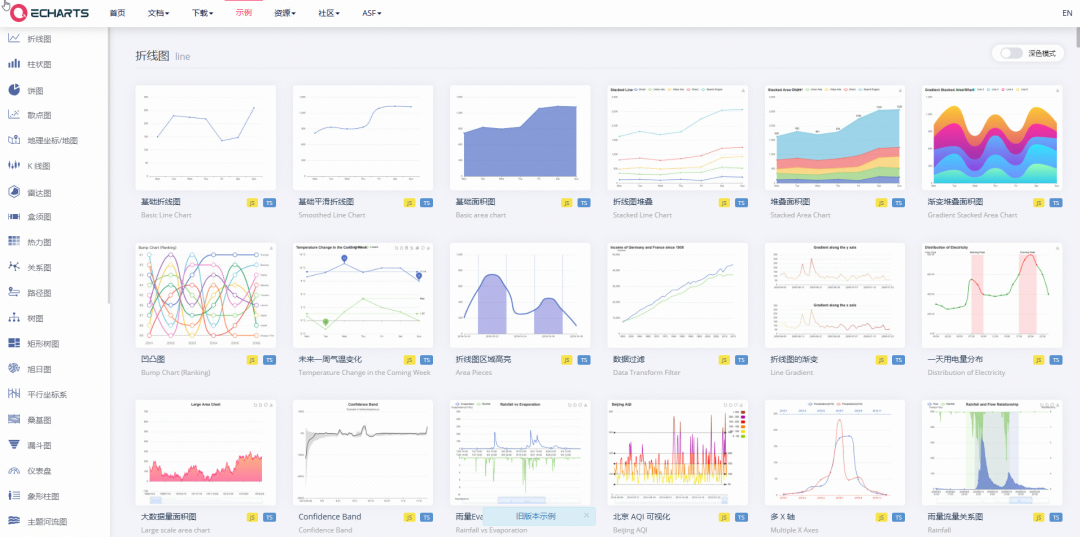
3.4. Intelligent Assistant: Enterprise WeChat Integration
Enterprise WeChat is currently the preferred platform for internal communication and collaboration in many enterprises, and its rich application functions provide a natural advantage for achieving efficient data flow and visualization presentation. Based on the enterprise WeChat platform, it is easy to create an intelligent assistant application to build a complete set of closed-loop processes from data acquisition to chart presentation.
In the management background of Enterprise WeChat, administrators can utilize the application development function provided by Enterprise WeChat to quickly create intelligent assistant applications. This process mainly includes configuring the basic information of the app, such as app name, app avatar, app profile, etc., so that employees can clearly recognize and trust the use of the app. At the same time, administrators also need to configure the scope of authority of the intelligent assistant application, clearly limiting the enterprise data resources that the application can access and the operations that can be performed to protect the data security of the enterprise.
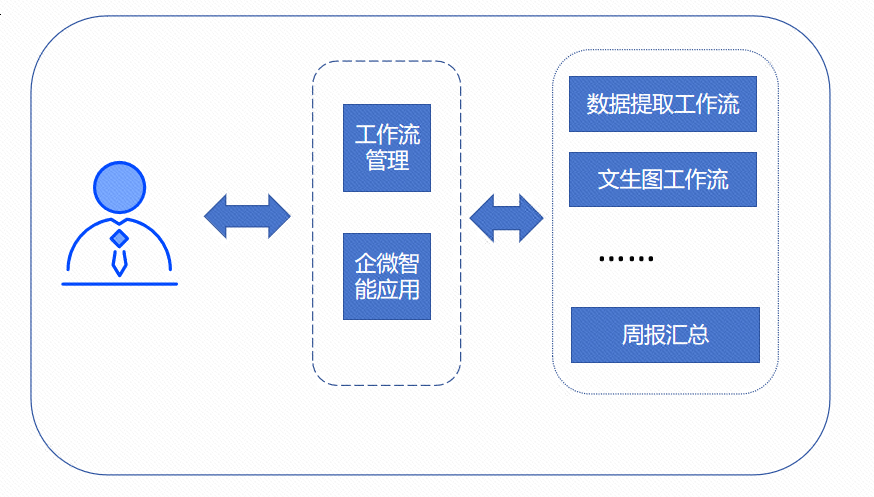
4. Demonstration of application effects
Taking the project management scenario as an example, project administrators can use the Enterprise WeChat Intelligent Assistant to quickly access project data and visually display it in the form of charts and graphs by means of natural language interaction.
For example, a program administrator might want to see trends in the addition of user stories from the previous year by simply asking the intelligent assistant something like, "Check last year's Story The system automatically generates a line graph of the trend in user story additions for questions such as "Trend in additions to user stories".
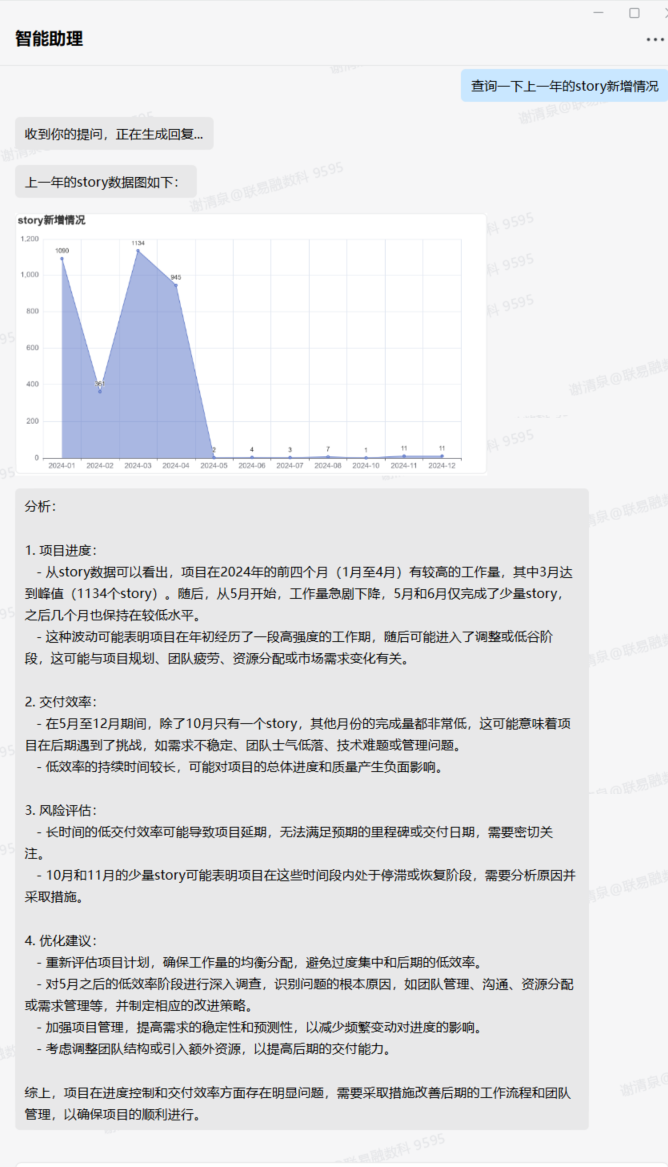
As another example, a project administrator may want to see the severity distribution of defects over a specific time period to assess the quality of development. Simply ask the question, "Look at the distribution of bug severity over the past quarter," and the system quickly presents a pie chart of defect severity.
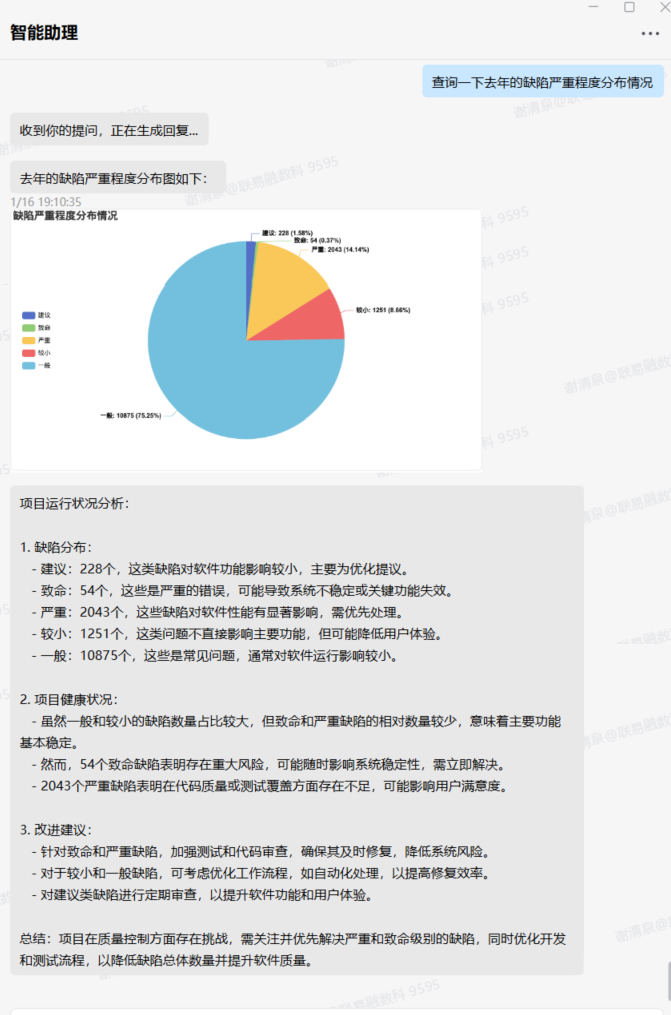
For example, a project administrator may want to see the planning for a particular iteration in the previous year, simply ask the question "I want to know the planning for the August iteration next year", and the system will generate a Gantt chart of the corresponding iteration planning.
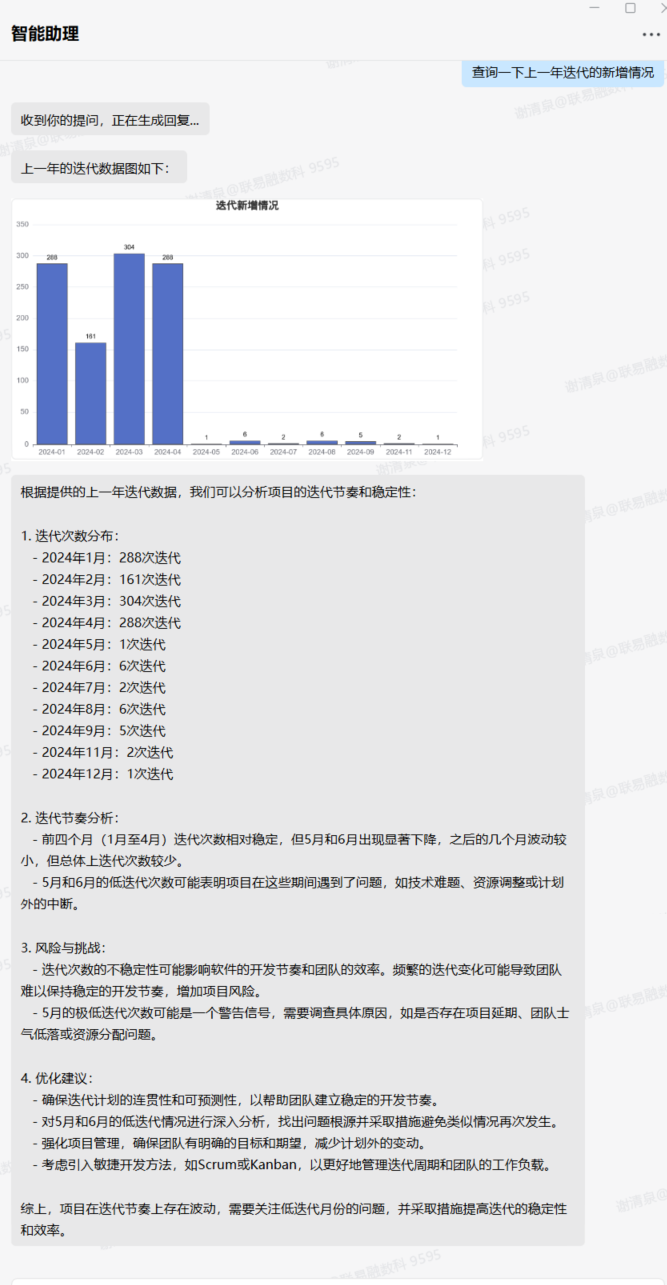
5. Programmatic values and strengths
5.1 Significant efficiency gains
In the past, if an employee needed to obtain data, he or she would need to switch back and forth between multiple business systems to log in and perform tedious manual data screening and export operations, making the whole process time-consuming, laborious, and inefficient. Now, with the help of intelligent assistants, employees only need to put forward data requirements in natural language, and the system can automatically trigger the process of data acquisition, data processing and chart generation to instantly obtain the required information. This greatly shortens the data acquisition time, allowing employees to devote more valuable time and energy to more core business analysis and decision-making work, rather than spending on tedious data collection and organization. For example, if an employee in the marketing department needs to analyze competitors' market data, he or she may need to spend hours collecting and organizing data from multiple sources in the past, but now with the intelligent assistant, it only takes a few minutes to complete the task, which significantly improves work efficiency.
In addition, the low-code nature of Dify's workflows greatly reduces the amount of work required to build a data acquisition workflow. Business people do not need professional programming skills, through simple drag and drop and configuration can complete the creation of workflow. Moreover, the automated operation mode of the workflow reduces manual intervention, reduces the risk of data errors caused by human errors, and ensures the accuracy and consistency of data. Repeated revisions and reworks due to data issues are avoided, further improving overall work efficiency.
5.2 Substantially enhanced data visualization
With powerful charting libraries such as ECharts, Dify workflows can transform complex business data into intuitive and vivid visualization charts. For example, using line charts can clearly show the trend of data changes over time, and using pie charts can visualize the proportion of each part of data in the overall situation. Compared with traditional tabular data, visual charts are easier to understand and analyze. Enterprise employees, whether management or front-line business personnel, can quickly grasp the key information in the data to provide strong support for subsequent decision-making.
Moreover, ECharts Chart Library provides a high degree of customization ability, which can be personalized according to specific business scenarios and user needs. Users can flexibly adjust chart colors, fonts, styles and interactive effects to highlight key data information in the charts and enhance the relevance and effectiveness of data communication. For example, in the financial statement analysis scenario, different colors and eye-catching annotations can be used to highlight the trend of key financial indicators, so that business decision makers can understand the changes in the financial situation at a glance.
5.3 Strong promotion of teamwork
Dify workflow centralizes all data interactions and chart presentations on the unified platform of enterprise WeChat, breaking the data barriers between departments in the traditional mode. Employees from different departments can share data and visualization charts in real time based on the unified platform, facilitating cross-departmental collaboration and efficient communication. For example, sales and marketing departments can work together to develop согласованную (coordinated) marketing strategies based on the same sales data and market analysis charts, improving overall marketing efficiency and collaboration.
In addition, the intelligent assistant application makes the information transmission within the enterprise more timely and accurate. Employees can access the latest business data through enterprise WeChat anytime, anywhere, avoiding delays in work caused by lagging information and reducing distortions and misunderstandings in the process of information transfer, thus effectively enhancing trust and collaboration among team members.
5.4 Significant reduction in operating costs
The low-code nature of Dify's workflows dramatically reduces the amount of system development effort and enables the rapid use of AI technology to empower data applications, helping organizations to significantly reduce their investment in labor costs. Enterprises no longer need to hire a large number of professional data processors to complete the complex data processing and analysis tasks that previously required the collaboration of many people, effectively saving human resources expenditure.
At the same time, the application of Dify workflow can also help organizations reduce potential cost losses due to data errors and work delays. By improving the accuracy and efficiency of data processing, it can effectively avoid the waste of resources and loss of business due to wrong decisions, and reduce the opportunity cost due to workflow delays, thus creating more economic benefits for the enterprise.
6. Future outlook for AI-enabled enterprises
With the rapid development and increasing maturity of AI technology, the role of AI in enterprise operations management is evolving and is expected to completely disrupt traditional software development concepts and models. The traditional software development model usually relies on professional developers to spend a lot of time and energy writing code, resulting in long development cycles and high development costs. In the future, with increasingly advanced AI technologies, low-code and even no-code development platforms will become increasingly mature and popular, enabling non-technical people to easily build powerful software applications and democratize software development.
Taking the data processing and visualization system built by Dify workflow, enterprise WeChat and AI technology as an example, this is only the initial exploration and attempt of AI technology to empower the digital transformation and upgrading of enterprises. Looking ahead, employees from all departments of the enterprise can make full use of various intelligent AI tools to quickly build exclusive data processing and analysis applications according to their specific business needs, which will greatly shorten the application development cycle, quickly respond to business changes, and improve the overall agility and innovation ability of the enterprise.
In order to better embrace the AI-driven intelligent future, enterprises need to actively embrace AI technology and continuously improve AI literacy within the organization. This requires both employees and management to continuously learn AI-related knowledge, as well as actively carry out AI skills training to enhance employees' AI application capabilities.
On the one hand, enterprises should actively organize internal AI technology training to help employees deeply understand the basic principles, core technologies, typical application scenarios, and the combination of AI technology and their own business work, so that employees can skillfully master and use AI tools to solve problems in their actual work, and improve their work efficiency and innovation ability. For example, marketing staff can learn how to utilize AI to make accurate market forecasts and analyze user profiles, so as to formulate more effective marketing strategies; financial staff can learn and master how to use AI technology to carry out intelligent financial risk assessment and financial budget management and other work.
On the other hand, enterprises should also actively encourage their employees to cultivate innovative thinking, actively explore the application possibilities of AI technology in different business segments, and promote the comprehensive popularization and in-depth application of AI technology within the enterprise, so as to accelerate the overall digital transformation process of the enterprise.
Looking ahead, AI technology will continue to reshape the operation mode and development pattern of enterprises. Only by actively embracing the change opportunities brought by AI technology and continuously strengthening learning and innovative applications can enterprises maintain their leading position in the increasingly fierce market competition and ultimately realize sustainable development.
appendice
- Dify is an open source LLM application development platform
- ECharts official example link:https://echarts.apache.org/examples/zh/index.html#chart-type-line
© Copyright notes
Article copyright AI Sharing Circle All, please do not reproduce without permission.
Related posts

No comments...


